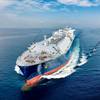The 49th of 62 planned Arleigh Burke Class Guided-Missile Destroyers honoring Admiral David Glasgow Farragut was christened July 23, 2005 at the Bath Iron Work, Bath Maine.
The Honorable Susan M. Collins, Maine senator and ship’s sponsor broke a bottle of champague across the bow to christen FARRAGUT in a time-honored navy tradition. In attendance was Commander Deidre L. McLay, USN the Prospective Commanding Officer who will become the first commanding officer of FARRAGUT (DDG 99).
FARRAGUT, designated DDG 99, is the fifth ship to carry the name, FARRAGUT. Four previous ships have been named FARRAGUT: a torpedo boat (TB-11) in 1899; a destroyer (DD 300) in 1920; a second destroyer (DD 348) in 1934 that earned fourteen battle stars in World War ll; and a guided-missile destroyer (DDG 37) in 1960 which took part in contingency operations in the Atlantic and the Mediterranean and earned a Navy unit Commendation.
James Glasgow Farragut was born on July 5,1801 near Knoxville, Tennessee, the son of a Spanish immigrant. Farragut’s naval career began at the early age of seven when a family friend, Captain David Porter, adopted him. He was provided the education and opportunities of a naval career. Farragut enjoyed the mutual trust and affection of his guardian and changed his name to David in honor of Porter.
In 1810, Farragut received a midshipman’s warrant and joined the ESSEX under Captain Porter’s command. At the young age of 12, he was given charge of a recaptured American ship by Captain Porter. Farragut took charge and sailed the prize to Valparaiso. He distinguished himself not only by the transit but also by the manner in which he subdued the original ship’s captain who challenged his authority.
During his naval service in the Civil War, Farragut engaged in battles at New Orleans, Port Hudson and Mobile Bay. Perhaps the most famous of Farragut’s engagement was at the battle of Mobile Bay.
On August 5, 1864 Farragut’s fleet was led by TECUMSEH, a Union ironclad, against the Confederacy’s Port of Mobile. In the heat of battle, the gun smoke from cannon fire created a heavy smoke screen which confused Farragut’s fleet trying to find their way in the channel. Farragut in his flag ship, HARTFORD, was caught in a cross fire between the Confederate ships and the fort. Farragut lashed himself on the HARTFORD’s topmast, over took for the lead ship which was disabled and sinking by an explosion from a chain of mechanically operated torpedoes(mines). Farragut ordered from the topmast, “Damn the torpedoes! Four-bells! Captain Drayton, go ahead! Jouett, full speed”. It has been often remembered as “ Damn the torpedoes - full speed ahead” .
The HARTFORD advanced over the mine field, scrapping the mines against the HARTFORD’s hull but the mine did not explode. Farragut lead his fleet to victory for the Union.
In 1864, Congress commissioned Farragut a vice-admiral. In July 1866, Farragut became the Navy’s first Four-star admiral. Admiral Farragut died in Portsmouth, New Hampshire at the age of 69.
Subscribe for
Maritime Reporter E-News
Maritime Reporter E-News is the maritime industry's largest circulation and most authoritative ENews Service, delivered to your Email five times per week










